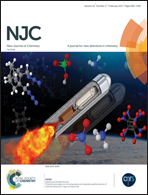Ultrafast igniting, imidazolium based hypergolic ionic liquids with enhanced hydrophobicity†
Abstract
Exploring ultrafast igniting and hydrolytically stable ionic liquids (ILs) has a wide scope in hypergolic rocket fuels. The hydrophobicities of ILs, induced by a smart change in alkyl substituents of imidazolium cations with energy-rich cyanoborohydride, [BH3CN]− and dicyanamide, [DCA]− anions were examined for the first time. The physico-chemical properties and performance of ILs were also studied. Consequently, hydrolytic stability in terms of moisture study of all the ILs was thoroughly investigated under standard environmental conditions. The analysis indicates that the IL 14, 1-allyl-3-octyl imidazolium cyanoborohydride is most hydrophobic and hydrolytically stable. Studies evaluating the role of the cationic hydrocarbon chain and the nature of anions of ILs on the properties of hypergolic fuel were carried out. All the ILs are liquid at room temperature and exhibit a positive heat of formation. IL 10, 1,3-diallyl-imidazolium cyanoborohydride exhibited the shortest ignition delay of 1.9 ms with WFNA and IL 11, 1-allyl-3-ethyl imidazolium cyanoborohydride presented the lowest viscosity of 16.62 mPa s. Therefore, these ILs can be suggested as potential candidates for replacing acutely toxic and carcinogenic hydrazine and its methylated derivatives as hypergolic fuels.



 Please wait while we load your content...
Please wait while we load your content...